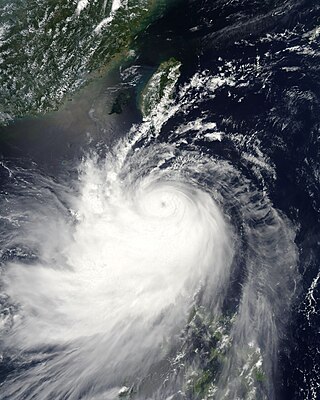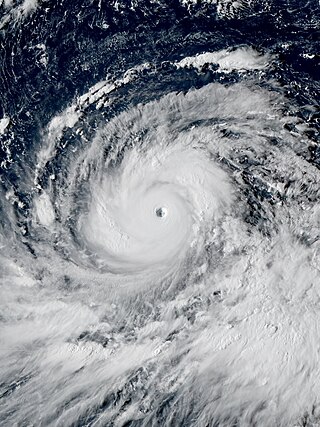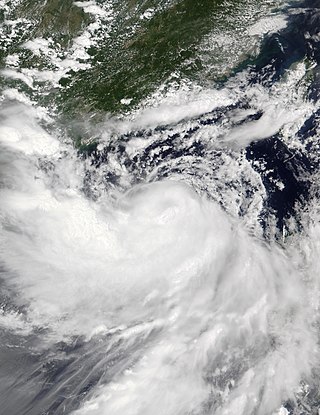Related Research Articles

The 2005 Pacific typhoon season was the least active typhoon season since 2000, producing 23 named storms, of which 13 became typhoons. It was an event in the annual cycle of tropical cyclone formation, in which tropical cyclones form in the western Pacific Ocean. The season ran throughout 2005, though most tropical cyclones typically develop between May and October. The season's first named storm, Kulap, developed on January 13, while the season's last named storm, Bolaven, dissipated on November 20. The season's first typhoon, Haitang, reached typhoon status on July 13, and became the first super typhoon of the year three days later.

Typhoon Nuri, known in the Philippines as Typhoon Karen, was the 12th named storm and the seventh typhoon that was recognised by the Japan Meteorological Agency. The Joint Typhoon Warning Center recognised it as the 13th tropical depression, the 12th tropical storm and the 8th typhoon of the 2008 Pacific typhoon season. The name Nuri was submitted to the World Meteorological Organisation's Typhoon Committee by Malaysia in 2003 after the name Rusa was retired in 2002. The name Nuri is Malay for a blue crowned parroquet, a type of parrot. The name Karen was assigned by PAGASA to a tropical depression for the second time, the other time being in 2004 to Typhoon Rananim.

Typhoon Vicente, known in the Philippines as Tropical Depression Ferdie, was the strongest tropical cyclone to strike the Chinese province of Guangdong since Hagupit in 2008, and was regarded as the strongest storm to affect Hong Kong and Macau in more than ten years. The eighth named storm and third typhoon of the 2012 Pacific typhoon season, Vicente began as a tropical depression on July 18, 2012 northeast of the Philippines. Vicente soon steadily moved into the South China Sea, and began to intensify above warm sea waters, and began explosive intensification early on July 23, and started to charge toward the Guangdong region prompting the Hong Kong Observatory (HKO) to issue the Hurricane Signal, No. 10, the first since York in 1999. The Macao Meteorological and Geophysical Bureau also hoisted Signal No. 9 for the first time since York and after the transfer of sovereignty over Macau. Late on the same day, Vicente made landfall over Taishan in Guangdong, China.

Typhoon Hato, known in the Philippines as Severe Tropical Storm Isang, was a strong tropical cyclone that struck South China in August 2017. The thirteenth named storm and the fourth typhoon of the Pacific typhoon season, Hato formed as a tropical depression over the east of Luzon on 19 August. The system further developed and became a tropical storm the next day. On 21 August, Hato emerged over the northern portion of the South China Sea and reached typhoon intensity. Rapid intensification ensued on 23 August, and Hato became a Category 3-equivalent typhoon before making landfall over Jinwan, Zhuhai. The storm further weakened over land and dissipated on 24 August.

The 2022 Pacific typhoon season was the third consecutive season to have below average tropical cyclone activity, with twenty-five named storms forming. Of the tropical storms, ten became typhoons, and three would intensify into super typhoons. The season saw near-average activity by named storm count, although many of the storms were weak and short-lived, particularly towards the end of the season. This low activity was caused by an unusually strong La Niña that had persisted from 2020. The season's first named storm, Malakas, developed on April 6, while the last named storm, Pakhar, dissipated on December 12. The season's first typhoon, Malakas, reached typhoon status on April 12. The season ran throughout 2022, though most tropical cyclones typically develop between May and October. Tropical storms Megi and Nalgae were responsible for more than half of the casualties, while typhoons Hinnamnor and Nanmadol both caused $1 billion in damages.

The 2023 Pacific typhoon season was the fourth and final consecutive below-average season and became the third-most inactive typhoon season on record in terms of named storms, with just 17 named storms developing, only ahead of 2010 and 1998. Despite the season occurring during an El Niño event, which typically favors activity in the basin, activity was abnormally low. This was primarily due to a consistent period of negative PDO, which typically discourages tropical storm formation in this basin. The season was less active than the 2023 Atlantic hurricane season in terms of named storms, the fourth such season on record, after 2005, 2010 and 2020. The season's number of storms also did not exceed that of the 2023 Pacific hurricane season. Only ten became typhoons, with four strengthening further into super typhoons. However, it was very destructive, primarily due to Typhoon Doksuri which devastated the northern Philippines, Taiwan, and China in July, becoming the costliest typhoon on record as well as the costliest typhoon to hit mainland China, and Typhoon Haikui in September, which devastated China, Taiwan, and Hong Kong. The season was less active in Southeast Asia, with no tropical storm making landfall in mainland Vietnam.

Typhoon Mangkhut, known in the Philippines as Super Typhoon Ompong, was a powerful and catastrophic tropical cyclone that caused extensive damage in Guam, the Philippines, and South China in September 2018. It was the strongest typhoon to strike Luzon since Megi in 2010, and the strongest to make landfall anywhere in the Philippines since Meranti in 2016. Mangkhut was also the strongest typhoon to affect Hong Kong since Ellen in 1983.

Typhoon Yutu, known in the Philippines as Super Typhoon Rosita, was an extremely powerful tropical cyclone that caused catastrophic destruction on the islands of Tinian and Saipan in the Northern Mariana Islands, and later impacted the Philippines. It is the strongest typhoon ever recorded to impact the Mariana Islands, and is tied as the second-strongest tropical cyclone to strike the United States and its unincorporated territories by both wind speed and barometric pressure. It also tied Typhoon Kong-rey as the most powerful tropical cyclone worldwide in 2018. The fortieth tropical depression, twenty-sixth named storm, twelfth typhoon, and the seventh super typhoon of the 2018 Pacific typhoon season, Yutu originated from a low-pressure area that formed in the western Pacific Ocean on October 15. The disturbance organized into a tropical depression on the same day, as ocean sea-surface heat content increased. Shortly after becoming a tropical depression, the Joint Typhoon Warning Center (JTWC) assigned the system the identifier 31W. The system continued to strengthen, becoming a tropical storm several hours later, with the Japan Meteorological Agency (JMA) naming the system Yutu. Increasingly favorable conditions allowed Yutu to explosively intensify, as the system maintained deep convection and subsequently became a severe tropical storm and then a typhoon.

Severe Tropical Storm York, also known in the Philippines as Tropical Depression Neneng, was a tropical cyclone that formed in September 1999. It brought severe impacts to the Philippines and southeastern China, causing 35 deaths. York is considered the worst tropical cyclone to hit Hong Kong since 1983. York was first noted as a tropical disturbance over the Philippine Sea on September 9, 1999, and became a tropical depression three days later on September 12. Initially, the intensity of the system was that of a weak tropical depression; however, it formed a new center while in the northern South China Sea west of Luzon soon after. York intensified into a tropical storm on September 13 and its track was erratic and remained stationary for a while, until it landfalled near Hong Kong as a minimal typhoon on September 16. York then weakened to a tropical storm and quickly degenerated into a remnant area of low pressure soon after on the following day.

Severe Tropical Storm Kompasu, known in the Philippines as Severe Tropical Storm Maring was a very large and deadly tropical cyclone that affected the Philippines, Taiwan, and southeast China. Part of the 2021 Pacific typhoon season, Kompasu originated from an area of low pressure east of the Philippines on 6 October 2021. The Japan Meteorological Agency (JMA) classified it as a tropical depression that day. A day later, the Philippine Atmospheric, Geophysical and Astronomical Services Administration (PAGASA) classified it as a tropical depression, naming it Maring. The cyclone was initially heavily disorganised, competing with another vortex, Tropical Depression Nando. Eventually, Maring became dominant, and the JMA reclassified it as a tropical storm, naming it Kompasu. Kompasu made landfall in Cagayan, Philippines, on 11 October 2021, and two days later, the storm made landfall in Hainan, China. The cyclone dissipated on 14 October 2021 while located over Vietnam.

Severe Tropical Storm Ma-on, known in the Philippines as Severe Tropical Storm Florita, was a tropical cyclone that impacted the Philippines in August 2022. The ninth named storm of the 2022 Pacific typhoon season, Ma-on originated as a disturbance over in the Pacific Ocean on August 18, and was upgraded to a tropical depression during the next day. The depression strengthened into a tropical storm receiving the name Ma-on, and became a severe tropical storm late on August 23 before making landfall in the Philippines. It would later make landfall in China and Vietnam on August 25. Ma-on weakened back to a tropical depression and due to unfavorable conditions it dissipated on August 26, 2022.

Severe Tropical Storm Nalgae, known in the Philippines as Severe Tropical Storm Paeng, was a very large and deadly tropical cyclone that wreaked havoc across the Philippines and later impacted Hong Kong and Macau. Nalgae, meaning wing in Korean, the twenty-second named storm of the 2022 Pacific typhoon season, Nalgae originated from an invest located east of the Philippines on October 26. The disturbance, initially designated as 93W, was eventually upgraded the following day to a tropical depression by the Joint Typhoon Warning Center (JTWC) and re-designated as 26W. The Japan Meteorological Agency (JMA) however, had already considered the disturbance as a tropical depression a day prior to JTWC's; the Philippine Atmospheric, Geophysical and Astronomical Services Administration (PAGASA) also followed the JMA's lead and gave it the name Paeng. That same day, it was upgraded again by the JMA to tropical storm status, thus gaining the name Nalgae.
References
- ↑ "REPORT OF THE FIFTY-FIFTH SESSION OF TYPHOON COMMITTEE" (PDF). Typhoon Committee. April 30, 2023. Retrieved April 30, 2023.
- ↑ "REPORT OF THE FIFTY-SIXTH SESSION OF TYPHOON COMMITTEE" (PDF). ESCAP/WMO Typhoon Committee. March 25, 2024. Retrieved September 1, 2024.